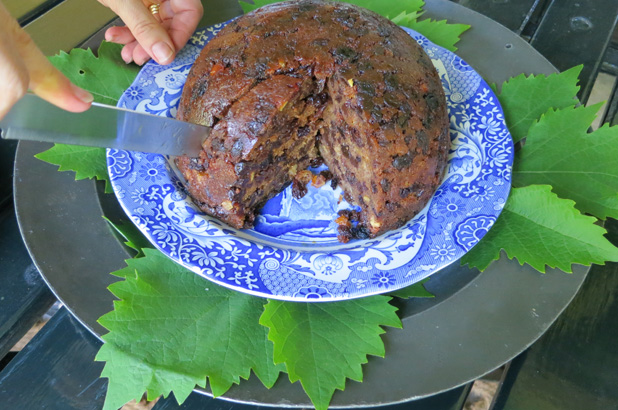Do you painstakingly prepare a pudding each year for Christmas Day only to find that, by the time it’s served, your family and friends have indulged in the festive spread a little too eagerly? Or, as often happens in Sydney, fresh mangoes, berries and cherries win out over hot pudding? Don’t despair – your efforts weren’t wasted!
Traditionally, pudding opportunities were not limited to Christmas Day. Plum puddings appear in several of Mrs Beeton’s January and February menu plans as they were ideal not only for Christmas, but also throughout the northern hemisphere winters when fresh fruit would have been in short supply.
The Victorians prided themselves on their ingenuity with leftovers; not necessarily because they were being mean or frugal but more as a demonstration of good household economy. Mrs Beeton gives a recipe for ‘Monday’s pudding’ – essentially a bread-and-butter custard, but using slices of pudding rather than bread. I’d tend to enrich it just a little by using half milk and half cream, otherwise it’s a very easy to follow recipe:
MONDAY’S PUDDING.
1312. INGREDIENTS – The remains of cold plum-pudding, brandy, custard made with 5 eggs to every pint of milk.
Mode.—Cut the remains of a good cold plum-pudding into finger-pieces, soak them in a little brandy, and lay them cross-barred in a mould until full. Make a custard with the above proportion of milk and eggs, flavouring it with nutmeg or lemon-rind; fill up the mould with it; tie it down with a cloth, and boil or steam it for an hour. Serve with a little of the custard poured over, to which has been added a tablespoonful of brandy.
Eliza Acton (1845) gives ‘The Good Daughter’s Mincemeat Pudding’ which is effectively a Bread and Butter Pudding with the bread spread generously with mincemeat mixture:
Author’s Receipt.
Lay into a rather deep tart-dish some thin slices of French roll very slightly spread with butter and covered with a thick layer of mincemeat; place a second tier lightly over these, covered in the same way with the mincemeat; then pour gently in a custard made with three well-whisked eggs, three quarters of a pint of new milk or thick cream, the slightest pinch of salt, and two ounces of sugar. Let the pudding stand to soak for an hour, then bake it gently until it is quite firm in the centre: this will be in from three-quarters of an hour to a full hour.from Modern Cookery for Private Families, 1845
Eliza’s ‘good daughter’s’ mincemeat pudding
| From book | Eliza Acton. Modern Cookery for Private Families. 1845 |
Ingredients
- 1 French-style brioche or soft baguette (sliced thinly)
- butter
- 1/2 cup fruit mince
- 200ml milk
- 250ml cream
- 3 eggs (well whisked)
- pinch salt
- 60g sugar
Note
Adapted from an Eliza Acton recipe published in 1845. We are assured by Eliza that this dutiful dish is her own original recipe.
Directions
| Preheat the oven to 160 °C. Butter the bread lightly and spread generously with fruit mince. Layer the slices in a deep ovenproof dish. | |
| Whisk the milk, cream, eggs, salt and sugar together and pour the custard mixture over the layered bread and mince. Set aside for 30 minutes to allow the bread to absorb the custard. | |
| Bake for approximately 45–60 minutes, or until the pudding is quite firm in the centre. | |

 Print recipe
Print recipe

